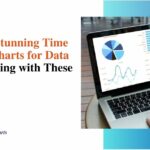Examples of Stacked Bar Charts in Business: From Sales Analysis to HR Management
Stacked bar charts are versatile visualization tools used across industries to compare categorical data across multiple dimensions. The key benefit of stacked bar charts is that they allow you to break down and compare subgroups within the same bar graph. This makes them ideal for analyzing performance by different segments like regions, product categories, campaigns, etc.
In business, stacked bar charts have many applications across sales, finance, human resources, customer service, project management, and marketing functions. They help simplify complex multifaceted analyses into easy-to-grasp visual snapshots, enhancing decision-making by providing actionable insights.
Let’s explore how to read a stacked bar chart.
Use of Stacked Bar Charts in Sales Analysis
For sales teams, stacked bar charts are indispensable for identifying trends, drilling down into performance drivers and spotting high-potential target areas across regions, product categories, salespersons and channels.
Regional Sales Breakdown
Viewing sales performance split by region is a starting point for many sales analyses. The visual splitting of national sales performance into regional building blocks quickly highlights which geographies are over or underperforming.
For instance, a stacked bar chart can reveal that while the North region contributes nearly half the revenues, its growth rate has been flat compared to the South’s rapid expansion. This indicates that more marketing resources may be allocated to support the Southern regional push.
Drilling down further, regional sales data can be distributed across states, cities or zones. This pinpoints specific latitudes for growth within regions. Sales leaders can spot underpenetrated territories and rearrange account resources or channel initiatives accordingly.
Product Category Sales Analysis
Beyond regional comparison, stacked bars help sales teams review revenues by product categories and sub-categories to discover market niches and opportunities.
For example, a category-level view may find that peripherals contribute almost a third of revenues, but their order values have recently been tapered. On the other hand, accessories form just 12% of sales but show an uptrend.
This analysis can lead product managers to control peripherals’ promotional budgets and re-energize accessories with newer models. Category reviews help optimize R&D and marketing spending towards pockets with more traction.
Stacked Bar Charts in Financial Reporting

Beyond sales statistics, Stacked bar charts are extensively used in financial analysis by finance controllers, auditors, and accounting professionals for expense monitoring, budgeting, revenue baselining, and cost driver identification.
Expense Variance Analysis
Detailed expense monitoring requires breaking down overall spending by business functions to uncover cost spikes or leakages at a departmental level. Stacked bars simplify the task by displaying total expenses sliced into color bands representing amounts consumed by HR, R&D, sales, production, admin, and other departments.
One quick look easily reveals if any particular unit’s share of expenses is expanding faster than normal. Finance teams can immediately probe outlier departments to check if higher spending is due to one-time overheads or points to structural issues in cost management.
Revenue Composition Comparison
To contain revenue uncertainty risks arising from overdependence on few streams, stacked bars help provide an easy snapshot view of all earnings channels and their proportional contribution to total revenues over time.
For example, tech companies can visually track the percentage of revenues that come from hardware sales, software licenses, subscriptions, ads, or data services. Any major shift in the mix indicates a need to revisit focus areas.
Expense Budget vs Actuals
An essential finance responsibility is tracking expense budgets versus actuals by function or geography. Stacked bars simplify variance analysis by overlapping normalised budgets with expenses distributed by department or location, with quick variance spots.
For example, the 9% overrun by the Production unit shows overspending against its capital expenditure budget and requires drilling down into expense sub-categories to correct the situation.
Application in HR Management
HR teams rely extensively on stacked bar analysis to monitor and ensure diverse, equitable workplaces across locations, levels, roles and employee communities.
Workforce Composition Analysis
For talent acquisition teams, stacked bars enable easy tracking of workforce diversity across locations, departments, roles, levels, experience bands and other collective groups.
HR can visually slice headcount on each stacked bar by gender, ethnic minorities, differently abled sections, and other dimensions of diversity. Any gaps in equitable composition quickly surface. Leadership can accordingly steer campus drives, referral incentives, and external partnerships towards entry-level technology teams or senior management brackets that exhibit uneven representation.
Turnover Analysis
Besides diversity reporting, stacked charts boost the retention program’s impact by depicting employee turnover rates sliced by division, office location, department, and specific desks.
HR can compare if Software Delivery teams witness more exits than Enterprise Sales groups or if interns drop out faster than mid-career hires. Common pain areas surface for leadership to target engagement interventions like team bonding, workplace perks or career planning connect sessions.
Customer Service and Support Analysis
Customer experience teams have built stacked bar playbooks to showcase complaint analysis, issue category spotlighting, and monitoring response time.
Customer Issue Analysis
Service agents easily detect widespread macro issues versus one-off grievances by splitting total complaints logged over any period into problem categories as individual color bands on bars. For example, a growing red chunk under Billing complaints indicates a need for finance to revisit process, while stray Service Delivery failures require localized troubleshooting. Such analysis guides resource planning for issue resolution.
First-Call Resolution Rates
An effective metric for monitoring team performance is the percentage of complaints resolved in the very first interaction vs. those needing callbacks/escalations. Stacked bars help depict total calls bucketed by resolution attempt—one-touch, two-touches, or more. Period-over-period comparisons help improve first-touch problem-solving.
Average Resolution Time by Priority
For call center reporting, stacked bars enable clear views of average resolution times by case priority bands like high/medium/low. Quicker turnarounds for simpler requests may be evaluated against critical case fixing schedules by plotting each stacked time segment as priority-wise color coded blocks.
Project Management and Resource Allocation
For project leaders, stacked bar analysis forms a pivotal tool for task tracking and talent deployment.
Phase-wise Task Completion
By dividing total timeline into color coded project phases as stacks on bars, managers can assess progress made across planning, design, development, testing and rollout stages. This helps provide a nuanced view compared to an overall project percent complete figure only.
Resource Spread by Focus Area
For matrixed teams, parsing headcount numbers by functions like product development, UX, quality assurance, tech writing, etc., helps evaluate optimal resource allocation across core delivery areas aligned to priority. Mismatches between talent demand and supply emerge for executive rebalancing.
Conclusion
As visualized through multiple real-world examples in sales analysis, financial reporting, HR and customer engagement, stacked bar charts enable multifaceted segmentation across regions, departments, resources, priority bands and demographic groups. This drives contextual insights to pinpoint growth levers like star salespersons, underperforming locations, budget overruns by department, service resolution gaps by ticket priority or campaign lift by micro-segments. Their versatility and easy comprehension of layered data splits make stacked bar representation an indispensable analysis toolkit for every business function.
The visual examination of data patterns using stacked bars foster more informed decisions around regional resource allocation, product mix priorities, hiring and retention policies, customer issue mitigation and marketing budget optimization for organizational leaders. This shapes data-driven strategy in today’s hypercompetitive markets.







